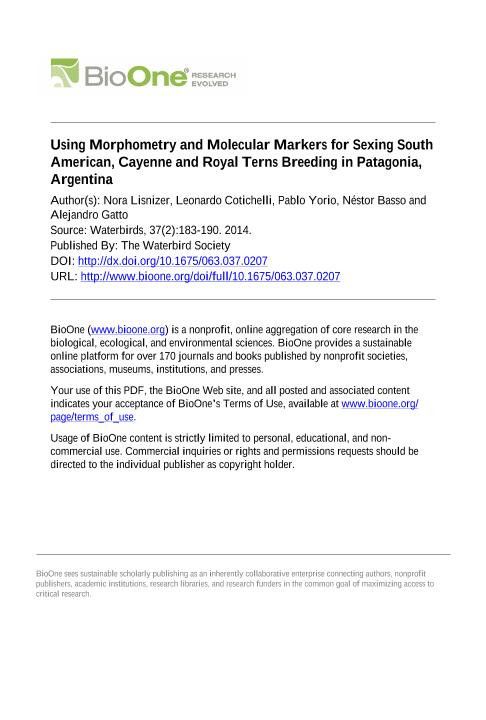Artículo
Using morphometry and molecular markers for sexing South American, cayenne and royal terns breeding in Patagonia, Argentina
Lisnizer, Nora ; Cotichelli, Leonardo
; Cotichelli, Leonardo ; Yorio, Pablo Martin
; Yorio, Pablo Martin ; Basso, Nestor Guillermo
; Basso, Nestor Guillermo ; Gatto, Alejandro Javier
; Gatto, Alejandro Javier
 ; Cotichelli, Leonardo
; Cotichelli, Leonardo ; Yorio, Pablo Martin
; Yorio, Pablo Martin ; Basso, Nestor Guillermo
; Basso, Nestor Guillermo ; Gatto, Alejandro Javier
; Gatto, Alejandro Javier
Fecha de publicación:
2014
Editorial:
Waterbird Soc
Revista:
Waterbirds (de Leon Springs, Fla.)
ISSN:
1524-4695
Idioma:
Inglés
Tipo de recurso:
Artículo publicado
Clasificación temática:
Resumen
The first information on the morphometry and sexual size dimorphism of the sympatric South American (Sterna hirundinacea), Cayenne (Thalasseus sandvicensis eurygnathus) and Royal (T. maximus maximus) terns from the Patagonia region in Argentina is provided, and a discriminant analysis to sex the three species is used. Morphological characters were obtained from South American Terns (n = 83), Cayenne Terns (n = 63) and Royal Terns (n = 20). All species were sexed using polymerase chain reaction-based molecular techniques. Sexes in the three tern species were only slightly dimorphic in size. Male Cayenne and South American terns were significantly larger than females in bill length, bill depth and head length. Royal Terns, in contrast, showed a high overlap in most morphological measurements, with head length being the only measurement that differed significantly between sexes. Head length correctly sexed 89% of South American Terns and 75% of Royal Terns, while a function including bill depth and head length correctly sexed 78% of Cayenne Terns. Our results provide a valuable tool for rapid sexing in the field of these three Patagonian terns, although reliable sexing in Cayenne and Royal terns should be preferentially achieved using a combination of morphometric and molecular sexing.
Archivos asociados
Licencia
Identificadores
Colecciones
Articulos(CCT-CENPAT)
Articulos de CTRO.CIENTIFICO TECNOL.CONICET - CENPAT
Articulos de CTRO.CIENTIFICO TECNOL.CONICET - CENPAT
Citación
Lisnizer, Nora; Cotichelli, Leonardo; Yorio, Pablo Martin; Basso, Nestor Guillermo; Gatto, Alejandro Javier; Using morphometry and molecular markers for sexing South American, cayenne and royal terns breeding in Patagonia, Argentina; Waterbird Soc; Waterbirds (de Leon Springs, Fla.); 37; 2; -1-2014; 183-190
Compartir
Altmétricas



